#letsdebunk
Explore tagged Tumblr posts
Text
I wrote a post trying to figure out why on earth some Pagans & Witches refer to Imbolc (an Irish spring agricultural holiday associated with St Brigid, a potential Christianization of the Goddess Brigid/Bríg) as Candlemas, the completely Christian holiday celebrating The Purification of Mary & Presentation of Jesus at The Temple— which originated in the eastern part of the Roman Empire (which the only "pagan" aspect was it competing with Roman Lupercalia for celebrants).
Many pagan & witch spaces online have a constant disdain for Christianity thus I could not wrap my head around them using such an important point of Jesus' & Mary's life as one of their festivals/'sabbats'.... then, after writing a bunch of stuff, I stumbled onto the answer on Wikipedia's Wheel of The Year page, which has citations for its claims:
Margaret Murray (very early 20th century scholar) in her now discredited witch-cult hypothesis said that the Scottish "witch" Issobell Smyth in 1661 confessed to attending meetings for witches on the cross quarter days included Candlemas. Robert Graves (oh how I loathe you ehem I mean: poet folklorist), mentioned that Candlemas was part of the 8 ancient British agricultural festivals. And Doreen Valiente ("The Mother of Wicca") included Candlemas in her list of Greater Sabbat Fire Festivals, while also listing "Gaelic counterparts," in this case Imbolc.
Sigh.
Early (read: 19th-20th century) paganism and witchcraft, or scholarly work about it, really was just: put every claim regardless of accuracy from any culture in this jar, shake it up real good, see what pops out from the mix, then pretend its historically attested to and traditional despite any and all evidence.
Also whatever Wikipedia writer wrote this, I appreciate your sassiness ... even if it was unintentional:
Due to early Wicca's influence on modern paganism and the syncretic adoption of Anglo-Saxon and Celtic motifs, the most commonly used English festival names for the Wheel of the Year tend to be the Celtic ones introduced by Gardner and the mostly Germanic-derived names introduced by Kelly, regardless whether the celebrations are based on those cultures.
EDIT: To be clear, not all neo/pagans, witches, wiccans, occultists, people-who-use-wheel-of-year are anti-Christian! I'm not trying to say that. But as a worshipper of Mary now, I notice it more and more. Nor am I saying all those people follow Murray/Grave/Valiente blindly but published works and trusted blogs often seem to. This is simply an observation, I've taken notice of, its not the entire communities.
#wheel of the year#imbolc#imbolg#candlemas#pagan#neo pagan#polytheist#witch#annoying history#theres a great post on the actual irish holidays from ya know an irish perspective#but i cant find it#holiday#mariolatry#first sorrow#deletes previous draft#should have just read wheel of year article first#letsdebunk#tag seems appropriate i guess
44 notes
·
View notes
Text
TIL .... about the psychogenic modes of child rearing that basically says people, especially mothers, didn't value and help children until the mid-20th century. And just.... ? (Oh but hunter gathers, Rome, Greece, and China are exempt from the model for vague reasons). It was created by Lloyd DeMause a person with a bachelor's in political science and training in psychoanalysis. Culminating in the "field" of psychohistory. I honestly wish psychoanalysis would fall off the face of this planet. Disinformation and misinformation about history being spread in books always leads back to a Jungian Analyst. And psychoanalysis is IMO extremely European-centric. Especially "archetypes". I just hate it, and this "modes of child rearing" shit that casts all humans (except the listed exceptions) as evil towards their children until ✨modern civilization✨ and the "helping phase"; has made my hatred of this "field" even stronger.
#psychoanalysis#psychoanalyst#psychohistory#what the fuck#history#really random thoughts#because the concept of that made me just angry#jungian analyst#letsdebunk
5 notes
·
View notes
Text
So I was writing a debunk of a quote from "When God Was a Woman" by Merlin Stone 1976, and I came across and entire PDF of the book. I actually spent a long time skimming through it and reading sections.
I really just hate this theory of some monotheistic pre-historic Mother Great Goddess; I hate peaceful matriarchal pre-history society theory even more. Were there cultures where Goddesses reigned supreme? Not impossible but books like this seem to not actually care about religion and care much more about a gotcha-moment argument for feminism.
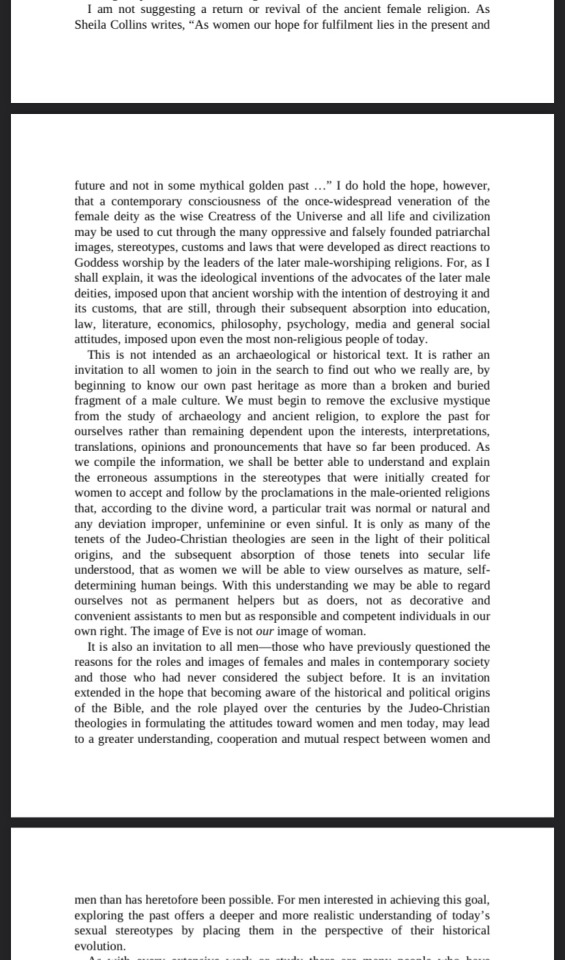
Its also extremely reactionary (not the word I'm looking for but close enough) to the dominance of current religions. Like you can tell just how much she can't stand "Judeo-christian" religion and values though out much of it, she mentions Islam as well at the beginning:
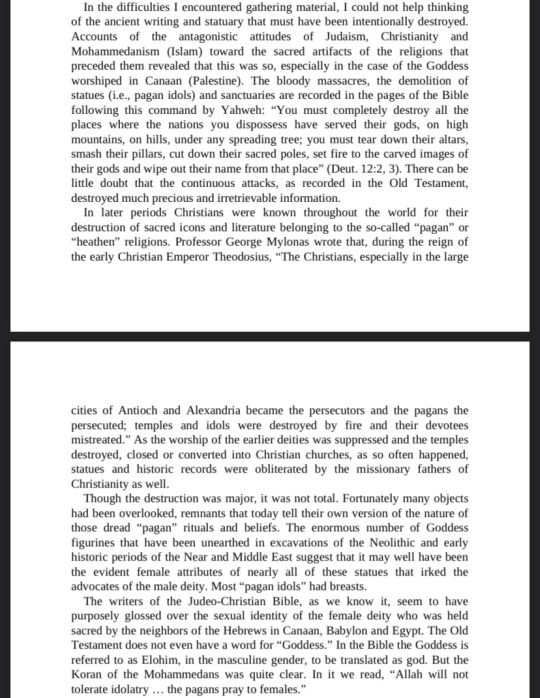
She eventually goes on to make the argument that the ruling elite of the "Hebrews" were actually Indo-European in origin. She takes the historical accounts of the Bible as fact way too much; I don't know if thats because the book was written in 1970s and the Bible was considered a better historical tool back then than as it is now or for some other reason. Either way the scholarly consensus (from many fields) shows that the ancient Israelites were just a Canaanite group no different from their neighbors in the Levant. They simply evolved with their own language and religion just as their neighbors did. Not that they lived in Egypt for generations and then invaded Canaan. A lot of her argument in some places relies on the idea that the Hebrews were outsiders, some coming from Egypt and invading Canaan at the behest of their God and others coming from the north Indo-Europeans/Indo-Aryans who had a male religion and the two groups combined and formed "The Hebrews" whose ruling elite were extremely antagonistic to the "Goddess Religion"
Which speaking of the Indo-European connection this was such a fucking bizarre passage that popped up when I was reading:
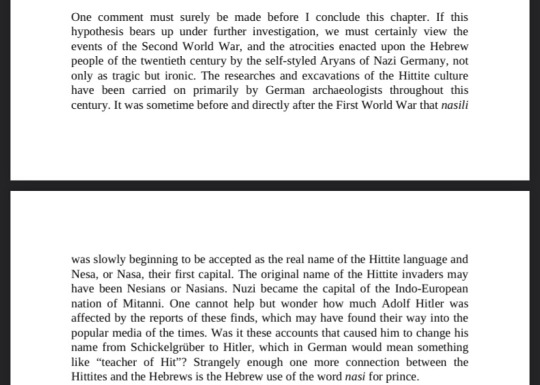
Like..... why did Hitler come into this discussion?
Also she makes the claims that earliest humans didn't connect sex to pregnancy and thus didn't have any sense of paternity and therefore saw woman as just magically being able to create a new human......and .... how stupid do you think our ancestors are?

The claims about aboriginal Australians is ridiculously reductive and the conclusions she draws from it are even worse. The only way to come to these conclusions is to study indigenous people through an extremely thick lens of "primitive people can't possibly understand science!" If anyones intrested in the idea you can read it here, paternity IS recognized (page 2) https://www.jstor.org/stable/2803097?read-now=1&refreqid=excelsior%3A338b1b647c8b5dd8b37523c756a9008c&seq=1#page_scan_tab_contents (you can get 99 articles for free each month if you want to read it)
Anyways, one thing I REALLY hate is, Goddess Religion Theory's desire to lump all Near Eastern & Mediterranean Goddesses as all the same. Like if you want to believe that, you do you, but its not history.

I literally have a post coming out soon (well "soon") that showcases how Astarte = Asherah is 100% false from the perspective of the ancient people who worshipped them.
I don't know why authors who approach the pre-history Goddess theory insist that all Goddesses were the same. Would a multitude of Goddesses detract from their argument?? I don't see how. Its especially weird considering this isn't religious apologetics shes not writing this as a theological or historical argument. She says herself this is to help woman view the world differently and draw new conclusions. So why is a ancient monotheistic Goddess preferred over polytheistic Goddesses? That was actually what I was going to debunk, a quote that called them all the same, but basically said screw it after finding the book and "reading" huge chunks of it.
One of the most annoying things is, unlike many books I debunk making dumb claims about Mesopotamia, Stone actually cites tons of sources. BUT she does it in such a way that its hard to fact check. No footnotes or endnotes just names and quotes with a MASSIVE bibliography. So I have no way of knowing if Professor [name] is actually in a field relevant to the claims they are making. For example, she cites Jacobsen, cool he's an Assyriologist, she also cites Robert Graves .... not so cool, he is mainly a poet. These two sources aren't on the same level of credibility when speaking about ancient religion. But I only know that because I know of both Jacobsen and Graves prior to reading this; allllll the myriad of other people she mentions I don't know. Without footnotes or endnotes it would be a arduous task to look up every person she is citing to see if they actually have credentials to support the claims in a 200+ page book. Sources wise she's fantastic simply because she actually provides them, unlike most. But the method makes it extremely frustrating.
Anyways. I'm 100% okay with Goddess Worshippers please don't think I'm not. If your a monotheist and view all Goddesses as The Singular Supreme Goddess or a duotheist who views them all as facets of The Goddess, or sees them as archtypes or whatever else— thats fine. What I hate is re-writing history to try and fit these claims. The people of the Ancient Near East and Mediterranean did not view all their Goddesses as the same, please stop twisting it to fit your new religion or your political ideology.
PS, its 1am I didn't proof read intensely sorry for spelling and grammar if its messed up
#polytheism#paganism#femenism#goddess worship#books#michibooks#letsdebunk#kinda that tag but not really
26 notes
·
View notes
Text
I see frequently everything pagans and recon/revive polytheists don't like gets shoved under "it's Christian baggage" label. For some cultures they feared the Gods, in others they don't.
If you don't want to fear your Gods (either because the ancient culture did not, or because you want to adapt to modernity) then don't— but don't dismiss the idea as Christian or even as monotheistic.
🔹Mesopotamian Example🔹
From Babylonian Pentinetal Psalms (*finding newer translations of these is difficult so this comes from early 20th century link) [Archive Page 2]:
Lord whose heart on high reposes not. Lord whose heart beneath calms not. Who above and beneath reposes not. Who has crushed me, who has undone me. Who has pat affliction into my hand. Who has put fear in my body. Who the iris of my eye has filled with tear's. Who has crushed my heart and filled it with sorrow. His pure heart I will appease; intercession unto him will I speak. May his heart by persuasion repose. May his soul by persuasion repose. "O heart repent, repent." be spoken unto him.
The Babylonians seem to be significantly more invested in sin and repentance compared to Sumerians. But I'm too tired to go find a source where I learned that, it may have even been conjecture on the part of the academic.
Another Psalm [Archive page 50]:
Ea has enlarged thy destiny among the great gods. The ordering of the Land into thy hand he entrusted, Fear of thy divinity doth fill the lands.
Lament for Sumer and Urim (ETCSL 2.2.3 with sources spelling):
An frightened the very dwellings of Sumer, the people were afraid. Enlil blew an evil storm, silence lay upon the city. Nintud bolted the door of the storehouses of the Land. Enki blocked the water in the Tigris and the Euphrates. Utu took away the pronouncement of equity and justice. Inana handed over victory in strife and battle to a rebellious land. Ninjirsu poured Sumer away like milk to the dogs. Turmoil descended upon the Land, something that no one had ever known, something unseen, which had no name, something that could not be fathomed. The lands were confused in their fear. The god of the city turned away, its shepherd vanished. The people, in their fear, breathed only with difficulty. The storm immobilised them, the storm did not let them return.
I don’t think we are meant to fear the Gods. Not even Gods of storms, death, or war. To believe in them is to accept them as they are. Don’t let anybody convince you that polytheists should fear the Gods. Be awe-struck, be humble before them if it feels right, but in this modern day and age, spirituality shouldn’t feel unsafe.
2K notes
·
View notes
Text
Honestly don't know how much I can go into detail with my current energy level.
But please, Hellenic Polytheists, avoid this website entirely.
I was a moderator for one of the creator's discords. He uses the identity "hellene" when he is a non-Greek white Canadian. He says Greeks gave up the right to our ethnic identity term when we became Christian.
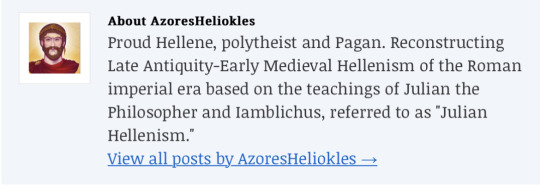

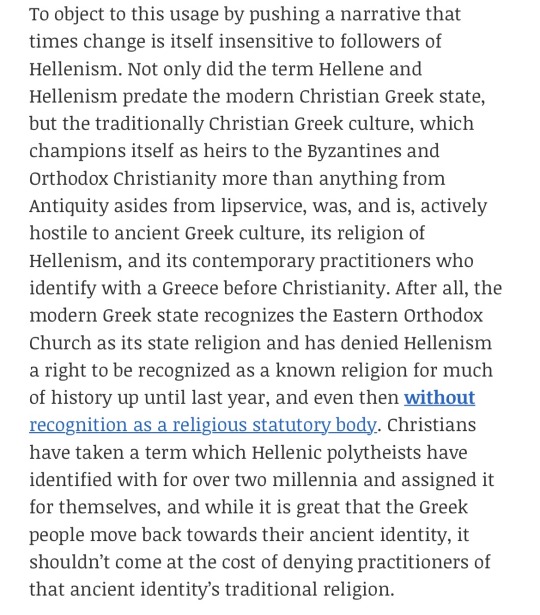
Article Here
Edit: found the tumblr version of this
He claimed that the only reason soft polytheists exist is because atheists want to cause division "Soft polytheists exist because atheists want to subvert polytheism by making actual polytheism or "Hard polytheism" look like an "extreme" fundamentalist position."
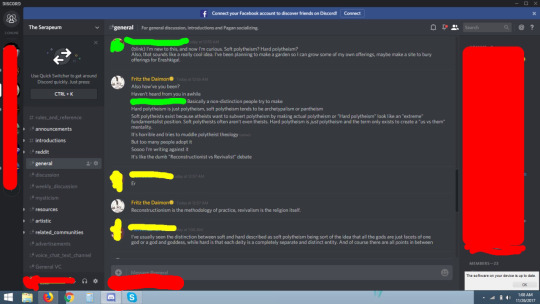
He went off on someone for not being a real "hellene" because the individual did not purify in a reconstructionist way in his words "underwhelming miasma." He dismissed that person as not a real follower of the religion and not a Hellene but instead as a "vague greek pagan."
Sorry for all the highlights and stuff this was from so long ago I don't have the originals

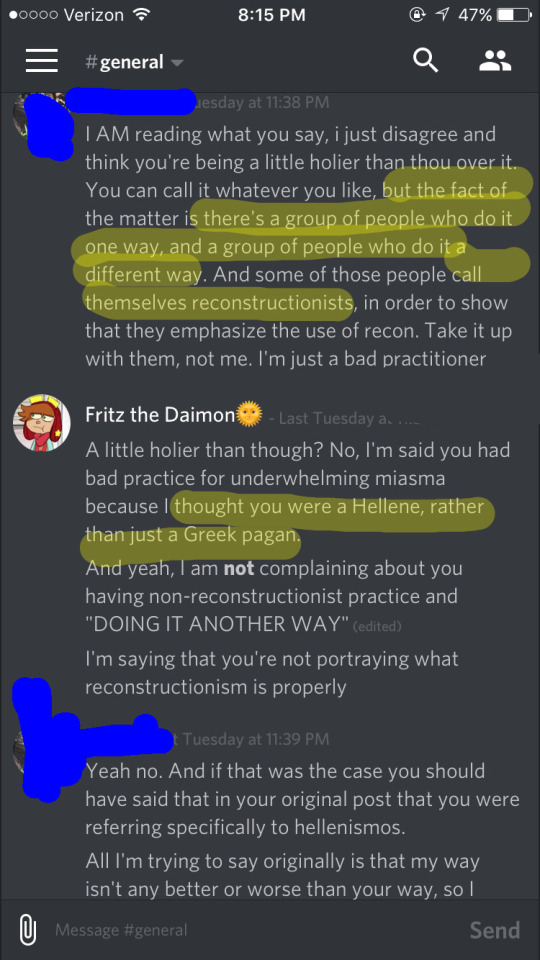
He also has a weird argument about the fact that "reconstructionist" cannot be a denomination (as in "hellenic reconstructionist" "hellenic revivalist" "hellenic pagan") he talks about it in his FAQ on reconstructionism, but his website looks all nice and professional. And nothing like how he talks in chat with others who disagree with him, which is childish, rude, and obstinate.

He is bigoted towards Greek people while claiming to be a hellene and taking a Greek name.
Also if you ever called Emperor Julian , "Julian the Apostate" he would lose it.
Maybe he has changed now, its been quite a few years, but that website is a result of the past time period where he acted as I have described. So long as he is bigoted and disdainful towards actual real Greek people, continues to call himself Greek, and denies that it is our heritage—I don't care if he has become nice and more polite.
(also not to mention the website is specifically Julian Hellenism from 4th century AD/CE, which is far after in time to what most Hellenic Polytheists base our religion on, so it isn't a good source for that anyways)
just found this site today and i'm blown away by the amount of information. if anybody needs a resource about pretty much ANYTHING to do with Hellenic Polytheism, start here. i've barely skimmed the surface of info on here, there's so much collected here
#helpol#hellenic polytheism#ofthetheoi#he lives in a fantasy land where greek people no longer exist when christianity became the dominating religion#and cant stand when a greek person argues against him#hence his ''yes yes I know hellenic refers to greek in general :P''#hellenicfaith#letsdebunk
11 notes
·
View notes
Note
The first paragraph is not scientific consensus at all.
Edit: Tone Note— This is meant to add to the post, not harm the OP or make them feel stupid, I like giving information which is why it's all quotes primarily. And I admire OP.
🔷 "Neanderthals may have used something similar to language though they had very different voiceboxes meant they could only use a limited range of sounds."
This is called the Larynx Descent Theory
The idea human vocal cords/larynx is special and gives us a special ability at speech is highly contested. It was first hypothesized in the 1960s-ish. But while it caught on, it never actually had a conclusive amount of evidence, and has been increasingly challenged recently.
This review produces three major findings. First, even among primates, laryngeal descent is not uniquely human. Second, laryngeal descent is not required to produce contrasting formant patterns in vocalizations. Third, living nonhuman primates produce vocalizations with contrasting formant patterns. Thus, evidence now overwhelmingly refutes the long-standing laryngeal descent theory, which pushes back “the dawn of speech” beyond ~200 ka ago to over ~20 Ma ago, a difference of two orders of magnitude. — "Which way to the dawn of speech?: Reanalyzing half a century of debates and data in light of speech science" in Science Advances 2019
Laryngeal descent theory (LDT). It was taught in textbooks and routinely disseminated in publications on the origin of language and seemed so evident that it was taken as canonical, even axiomatic. It was taken by scientists as explaining the failure to teach speech and language to home-raised chimpanzees. As documented below, researchers tended to overlook criticism of his conclusions, even serious arguments regarding articulatory capabilities of Neanderthals (23–25) or infants (26, 27), because these arguments could be discounted as tangential to the core of the theory, the vocalizations of nonhuman primates. Moreover, although LDT generally lacked support from speech researchers (see below), the LDT became an early foundational tenet of a complex school of thought claiming a recent, sudden, and simultaneous appearance of speech and language in AMHS (3). In our view (28, 29), LDT is a paradigmatic example of a “contagious idea” understandable through the “epidemiology of representations” framework developed in anthropology and cognitive sciences by Sperber (30, 31) to explain how some theories spread more quickly and broadly than others, sometimes before the formation of any consensus on their scientific validity — Same as above
This descended larynx has traditionally been believed to distinguish humans from all other mammals, in whom the larynx rests at the back of the oral cavity. The acoustic and evolutionary significances of this trait were first realized during the 1960s: having a low larynx allows humans to create a wider range of vocal-tract shapes, and thus more varied and distinctive speech. sounds, than other mammals A lowered larynx has thus been considered a key anatomical prerequisite for modern human speech and extensive debate has focused on precisely when in hominid evolution the larynx descended. The beliefs that a descended larynx is uniquely human and that it is diagnostic of speech have played an central role in modern theorizing about the evolution of speech and language. In this report, we document descended larynges in males of two deer species, the red deer, Cervus elaphus, and the fallow deer, Dama dama, thus demonstrating that this feature is neither unique to Homo sapiens nor necessarily tied to speech production. — "The descended larynx is not uniquely human." in Proceedings of the Royal Society B: Biological Sciences 2001
Additionally Neanderthals may have had languages like us, since we aren't as anatomically special as we thought we were:
Our results show that the occupied bandwidth of Neanderthals was greater than the Sima de los Huesos hominins and similar to extant humans, implying that Neanderthals evolved the auditory capacities to support a vocal communication system as efficient as modern human speech. — "Neanderthals and Homo sapiens had similar auditory and speech capacities" in Nature Ecology and Evolution 2021
This research suggests that other Homo species had the ability to produce speech sounds that overlap with the range of speech sounds of modern humans, and that species such as Neanderthals possessed genes that, in humans, play a role in language. But we do not know whether these archaic hominins actually produced speech, and if so, to which extent it was similar to our capacity for language. As of now, the anatomical and genetic data lack the resolution necessary to differentiate proto-language from modern human language. — "Dating the Origin of Language Using Phonemic Diversity" in PLOS ONE 2012
🔷 "All modern human languages are thought to be descended from one unknown language, spoken at most about 180,000 years ago"
This is called the Proto-World / Proto-Human Language
There is not even remotely enough evidence for the proto-world theory—the idea that all languages on earth descend from one 180,000/150,000 years ago—to be stated as fact in anyway. Or at least not without a big disclaimer.
Linguists are sort of divided on the topic, most not in favor of it; primarily because the mere ability to analyze or find evidence for the hypothesis is near impossible to begin with. It is a hypothesis for sure, but the evidence is scant and all methods can be criticized.
Q: Do all languages come from one language? The Proto-World theory suggests that there was one proto-language that is the origin of all languages today. Even though there is some evidence to support the theory, many linguists strongly disagree with it. — "Proto-languages and Their Evolution" on Wondrium 2020. | This professor John McWhorter from Columbia University has a huge course on the history of human language on Wondrium
The paper concludes that it is highly unlikely that use of comparative linguistics can be used as a method as far back as the origins of human language. [...] Whether or not Ruhlen's notion of a proto-human language is a reality or not is difficult if not impossible to determine using the evidence of the present. — "A Proto-Human Language: Fact or Fiction" in The University of Western Ontario Journal of Anthropology republished 2023. | This individual supports the proto-human language but explains why evidence is nearly impossible to prove it.
Where possible, [Evolution of Human Languages] linguists are attempting to reconstruct – and then compare – ancestor languages, moving ever closer to the first human language. Viewed by many linguists as a fringe movement, the project has attracted much criticism. Many linguists say that historical languages cannot be studied beyond an 8,000-year threshold; they change too much, they say. Some take issue with the project's methods: A few words shared among reconstructed languages doesn't prove a familial relationship, they insist, especially far back in time. — "Linguists seek a time when we spoke as one" news article in Christian Science Monitor about a scientific study's / researchers goals 2007
Also this is from the wikipedia page but it gave me a laugh:
The concept [Proto-Human Language] is speculative and not amenable to analysis in historical linguistics.
because I had to look up 'amenable': "(of a thing) capable of being acted upon in a particular way" Makes the quote sounds straight up sassy.
-Not audio proof read-
Is it true that the Sumerian was the first human language on Earth?
It is not! Humans have been using language for hundreds of thousands of years, at least since the evolution of anatomically modern humans 200,000 years ago. Current scientific consensus is that language evolved gradually, and human relatives like Neanderthals may have used something similar to language, though they had very different voiceboxes meant they could only use a limited range of sounds. All modern human languages are thought to be descended from one unknown language, spoken at most about 180,000 years ago in eastern Africa (though multiple human languages may have existed at that time). And human language continued to change, evolve, and diversify over the subsequent tens of thousands of years.
Sumerian, instead, is one of the oldest written human languages. Writing was also invented gradually, so there may be languages recorded in proto-writing mnemonic systems older than Sumerian, dating back many thousands of years. But linguists consider the first full writing system, depicting the full range of a language, to have been used in Uruk in Sumer, around 3400 BCE. Writing may have been invented simultaneously and independently in Egypt (in the form of hieroglyphics), or have been influenced by the rapid spread of cuneiform writing from Mesopotamia. So Sumerian and Egyptian are normally considered the two earliest written languages.
#language#pre history#letsdebunk#I don't know if the formatting on this looks as bad on PC as it does on my un-updated mobile app#sorry about that#sumerian
122 notes
·
View notes
Note
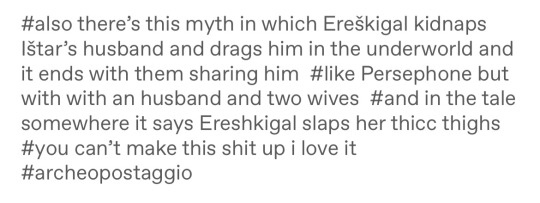

A lot of this information isn't quite correct, or is misunderstood. This is kind of all made up so the tag is a little ironic. *Note: I simply want to correct misinformation and add some details. This is not meant to harm who I am replying to.
🌹🌹Alternatives to Lilith🌹🌹
🌹🌹Accurate information on Tiāmat🌹🌹
*Tiāmat was made into the earth, rivers, mountains and sky not just the sky.
🥀 Half Bird of Prey 🥀
First the "half bird of prey," claim is not attested. Even if one considers the Burney Relief ...

...to be Ereškigal (thats heavily debatable) having bird talons for feet doesn't make her "half a bird of prey." If this were true the bird bit would appear in her mythology somewhere. It doesn't appear in either Inana's or Ištar's Descent myth [1] [2] it doesn't appear in either Myth with Nergal [3][4 page 83] it doesn't appear in Enkidu, Gilgamesh, and The Netherworld where she is given Kur to rule [5]. Other mentions of her are temples and offering lists [6] [7] There is no indication that she was partly a bird. As for wings, Inana (Oriental Institute of the University of Chicago) Ninurta (Taken from Wikipedia confirmed by [8]), and Šamaš [8] also have them.
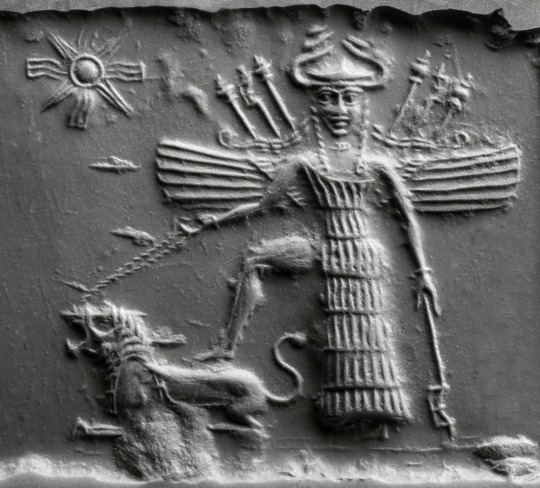
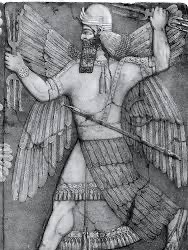
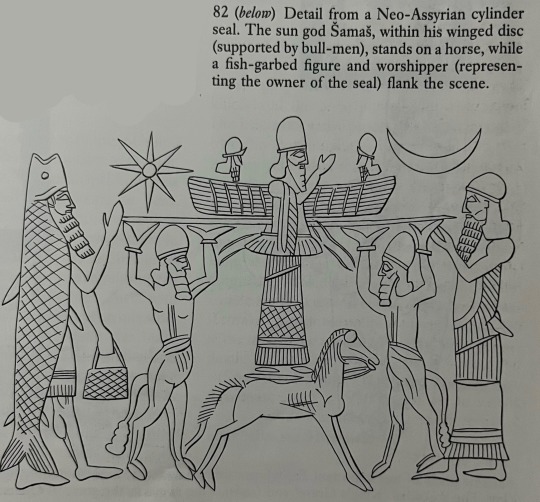
Lions are more associated with Inana not Ereškigal [8] And clearly the lions aren't crushed, they would most likely have mouths open, as fierce animals and monsters have them open when being fought or defeated; shes simply standing on them.
Since the relief is debatable as either Ereškigal or Inana that would make Inana potentially "half bird of prey" too, but that is also untrue
🥀 Half Human 🥀
She is not a human, not even half.
Humans are not Gods except kings in some periods [8] such as Ur III. Unlike other mythologies almost no major Mesopotamian deities are half human. Even when Kings and other people claim to have a divine parent that doesn't necessarily put them on the level of the Gods: able to wear their crown and hold a tablet of destiny, as far as I have seen in my research but I am not fully read up on deified kings.
One big "exception" is Gilgameš. For example Bilgames (Gilgameš in Akkadian) was probably an Early Dynastic I period King who became deified and worshipped by ED II period. By Ur III, 230+ years after ED II, the first literary tradition of Bilgames/Gilgameš occurs and the Ur III divine kings tried to link their lineage to him or honored him as a God. By the time of the "standard" Epic of Gilgameš, 700ish years after Ur III, he is described as two-thirds god and one-third man, but is mortal and is "punished" by the Gods for his tyranny and his depictions do not show him wearing the divine crown. [So sorry I don't have all the citations, I wrote this awhile ago and don't remember exactly which sources]
Ereškigal is never mentioned as partially human, in any of the myths I've already provided.
There is nothing to suggest that Ištar or Inana and Ereškigal are twins. Sister's yes, twins no [6][7][8][9][10] In fact who Inana's father is depends on time and location [8][10], who Ereškigal's father is unclear.
🥀 Sharing Dumuzid / Tammuz 🥀
This part was what bugged me. It feels almost offensive to the deities involved.
For starters, Ereškigal has her own husband. Gugal-ana, who we don't know if he was worshipped or considered "living" prior to his death in Inana's descent. And in later time periods her husband was Nergal [9]. In the Nergal myth it is clear that when Ereškigal loves, she loves deeply. I wrote about that here. Gugal-ana might even be a "cloaked" version of Enlil [11]
Inana also loves very deeply. When a woman sleeps with Dumuzid she is heart broken and condemns the woman to death and throws her to a mob [12 page 24]
The only myths we have concerning this statement are Inana's Descent myths (there is technically a few extra pieces of literature related to Inana descending that you can find if you peruse the ETCSL) [1] and Ištar's descent myth [2]
Dumuzid is never said to have been shared with Ereškigal nor does she kidnap him— galla kidnap him and its Inana's fault. Inana haughtily went down to the underworld thinking she could have her way, sat on Ereškigal's throne and was judged then killed for the actions. Enki had to send creatures to lament with Ereškigal (a deep sign of empathy & kindness) so that she would offer them something as a thank you. They asked for Inana's corpse. They brought her back to life and she headed to the world of the living. However, Kur is the "Land of No Return" and the galla demons aren't going to let her leave just because Ereškigal gave a corpse over. They followed her, requiring a substitute, she comes before multiple friends of hers who are grieving appropriately (something extremely important and valued) and tells the galla they cannot take them. Then she finds Dumuzid strutting around not grieving properly and in anger & heart break gives him over to the galla in retribution. Eventually it's decided that Dumuzid and his sister Ĝeštinana will switch of spending 6 months of the year in Kur. There is no mention of Ereškigal "sharing" Dumuzid during those 6 months. Sourcing of this is mainly from simply reading [1] but also I'm sure some of my knowledge came from [13], other literature in the ETCSL, and other sources.
Tammuz on the other hand is kind of an odd addition in Ishtar's descent and it's unclear why he appears in Ištar's version of the myth [4 page 81]
🥀 Slapping Thigh 🥀
This isn't sexual.
This is simply a phrase in Sumerian culture. It means one is angry & annoyed. Kind of like someone today might say "knee slapping" to mean hilarious. [4 page 80 footnote 90] Nor is it described as "thicc" or any other adjective we could vaguely translate to that idea.
🥀 Sources 🥀
[1] Inana's Descent into the Netherworld ETCSL 1.4.1
[2] Descent of the Goddess Ishtar Into the Lower World Jastrow 1915 Translation.
[3] Earlier Armana Tablet Myth of Ereškigal & Nergal. Here
[4] Later Sultantepe Tablet Myth of Ereškigal & Nergal in The Ancient Near East: An Anthology of Texts and Pictures edited by James A. Pritchard book, available on the Internet Archive Library (free account)
[5] Gilgamesh, Enkidu and the nether world. Version A from Nibru ETCSL 1.8.1.4
[6] A Dictionary of Ancient Near Eastern Mythology by Leick book page 55. Internet Archive.
[7] A Handbook of Gods and Goddesses of the Ancient Near East by Frayne & Stuckey book page 101. Google Books (can't find PDF)
[8] Gods Demons & Symbols of Ancient Mesopotamia by Black & Green. Internet Archive.
[9] Ereškigal on Oracc
[10] Inana/Ištar on Oracc
[11] The Image of the Netherworld in the Sumerian Sources by Dina Katz. Screen shot that section here at bottom.
[12] The Harps That Once by Thorkild Jacobsen — "Unfaithfulness" Google Books (hopefully linked to page)
[13] Treasures of Darkness by Thorkild Jacobsen. Internet Archive.
-dyslexia: not audio proof read-
-divider credit: @/riftdancing-
Is there a less cringe female figure in the same vein as Lilith that one could look into for worship purposes?
I would recommend looking into the proto-semitic deities that likely inspired Lillith! And there's always the thelemic Babalon, who is clearly inspired by Lillith but with heavy emphasis from Ophite and Hermetic mythology.
And hey there's always Hecate, and Lady Nyx. Occult mythology is full of scary goth women.
707 notes
·
View notes
Text
Note to readers: I wrote this before checking their blog. This person claims they've experienced "apotheosis" (divinehood/deification: wikipedia info) and that they have a "genuine claim to the label godkin" and in a separate post states "I am not human. I am magic." Also outright tells Haides "So you, Hades, you fucking bastard, dickless coward with a poorly-shaven beard and no sense of true pride." and says that Hades godspouses should beware because they "hate your hubby and he hates me" 🙃 So why am I interacting? Because this took way way too much work, so I'm not deleting it. But the person I'm responding to, you can just ignore this because I have no patience for anyone claiming any level of divinity, even if its a past life, nor patience for anyone who outright insults any Theos especially to that degree and openly hates them. As for readers do not send this person hate or harass them if you have a problem with them/their statements just block. Stay out of their inbox don't be an asshole.
-🔹-
Anyways moving on...
But it's still.. You have to take the time to get to know a deity.
Fun fact: No you don't!
How many Athenian's had to get to know Athena before worship? Everyone? No. Most people? No.
How many people of Ur had to get to know Inanna & Nanna before worship? Everyone? No. Most people? No.
How many Japanese people need to get to know their local Kami (Ujigami) before worshipping them? Everyone? No. Most people? No. (Kami aren't 100% synonymous with "Gods")
How many Taiwanese & Chinese people need to get to know Mazu before worshipping her? Everyone? No. Most people? No.
How many Hindus need to get to know Shiva before worship? Everyone? No. Most people? No
Its almost like polytheistic practices are followed by hundreds of millions of people.
You absolutely DO NOT need any sort of interpersonal connection with a deity— you don't need "quality time" like some sort of friendship to get to know them at literally any point: be it your first week of worship or your 12th year. Nor do you need to have any sort of sign, knowledge of their personal preferences, or whatever other UPG this community won't shut the fuck up about. More loud emphatic discussion here.
The prep someone needs to do is accepting that working with a deity will change your life and circumstances, mentally or otherwise. There's no avoiding that.
I must be some sort of miracle then because I certainly did no preparation. I've been practicing for over a decade. Polytheism is not hard. It just fucking isn't. Have some more emphatic discussion here.
-🔹-
Polytheistic cultures past and present wove the Gods (and many other types of spirits) into their lives and communities. Because The Gods and a variety of spirits are just apart of life.
You don't need to "get to know" Hestia before worshipping her. Not every ancient Greek person took the time to focus on religious practice enough for such a feat of "getting to know" her. For them it's simply a fact that the hearth played a role in domestic rites [1]. She was also fundamental in some cities' politics [2] stressing how inseparable religious beliefs and political activities were. Ancient Greek festivals were plentiful, mixed "religion", sport, art, and sense of community [3]. Not all participants got to know the Gods being celebrated— and their worship was no less sincere.
You don't even need to "get to know" your personal Diĝir, they could be nameless, related to your profession, related to your family, or one of higher cosmic Gods [4] [5]— kind of like a patron saint though not exactly. Its a thing that sounds alien to Mesopotamian tradition since paying honor to the Gods, was necessary for the well being of the person, the household, and the city/empire [6], it wasn't some personalized cultivated spiritual endeavor by every Mesopotamian. Gods where not some separate domain. Not to mention divination was a profession [7] since it is utterly absurd to imply every ancient person communed with the divine for guidance by themselves.
You don't need to "get to know" Amaterasu-Ōmikami or Oharashisama [8] before installing a Jingū Taima [9] within a Kamidana— which Ise Grand shrine distributed 4 million in 2011 [10]. Japanese people might have Kamidana in their homes— but they also might in their workplace [11] (not all have Jingu Taima). Because Kami are not some separate religious thing that needs to be deeply learned by every individual person in Japan. Japanese people make the first shrine visit within the first 3 days of the year called Hatsumode. And its not a small number, 3.5 million visited Meiji Jingu, 3.1 million to Kawasaki-Daishi, 2.7 Million to Fushimi-Inari and also 2.8 million to the Senso-Ji Buddhist Temple [12] and there are thousands of shrines in the country. Kami, (as well the various Buddhist spirits that I don't know enough to talk about but here is some info), are simply apart of life, they aren't entities you need to square out time in your day to "get to know," them.
You don't need to "get to know" Mazu before going on the Dajia Mazu Pilgrimage, that 4 million people attend each year [13]. She has 5000 temples and her veneration is listed by UNESCO as a representative of Intangible Cultural Heritage of Humanity [14]. One of her Temples, Thian Hock Keng, is designated as a National Monument of Singapore [15]. Chinese folk religion isn't some sort of central institution. It communal. You can go to a temple, buy some incense, pray with it, and leave it in the incense holders (if they are there) without ever "getting to know" a God or spirit [16]. Trying to define it as a religion in the western sense fails to capture the actual tradition because the practice is cultural and readily mixed with other Chinese philosophies not some religious "identity" [17].
The idea that any ancient pantheon required everyone to have interpersonal (getting to know) relationships with deities or that culture's variety of spirits is utterly absurd, we are talking hundreds to thousands of people depending on time and place.
So. No. You don't need to get to know them. This should make the meaning of my original post crystal clear.
🔷 Notes 🔷
▪️ THIS EXCLUDES CLOSED PRACTICES
▪️It is important that you follow tradition when worshipping Kami and be respectful when visiting Shinto Shrines & Buddhist Temples (info) and also when visiting any variety of Chinese/Taiwanese Shrines/Temples (info).
▪️I didn't add a section of Hinduism because I ran out of energy whilte writing this. I was using these three as the proof of living traditions— there is no reason to think these principles were different in 'dead' traditions.
▪️Didn't even attempt to proof read this I'm so tired by the end. Whatever dyslexia did in a first draft just go with it.
▪️Read article on Haides (link) or better yet peruse his Theoi Project page (link)
▪️Sources:
[1] Referencing a review written by John Gladhill of Household Gods: Private Devotion in Ancient Greece and Rome by Alexandra Sofroniew. Link
[2] "Hestia: Hearth, Goddess, and Cult" by Mika Kajava in Harvard Studies in Classical Philology 102. Link.
[3] "Ancient Festivals and Their Cultural Contribution to Society" by Ioanna-Soultana Kotsori. University of Peloponnese, Kalamata, Greece. Link.
[4] Summary of "The Personal Deity in the Ancient Mesopotamian Religion" lecture give by Prof Ichiro Nakata Doshisha University. Link.
[5] Treasures of Darkness Chapter 5 by Thorkild Jacobsen. Internet Archive — though it says borrowing is unavailable.
[6] "Living Deities: Ancient Mesopotamian Patron Gods & Their Statues" by Iilias Luursema (MA & MS) in The Collector. Link.
[7] "On the Beginnings and Continuities of Omens Sciences in the Ancient World" by Amar Annus in Divination and Interpretation of Signs in the Ancient World, University of Chicago.
[8] Daijingu Temple of Hawaii had their Jingu Taima listed as for Oharashisama, the household God. Link. While generally Jingu Taima are seen as representing Amaterasu-Ōmikami as mentioned in source 9. From what I've read Jinja Honchō, Association of Shinto Shrines, doesn't actually define Jingu Taima.
[9] "Jingū Taima" by Nakanishi Masayuki in the Encyclopedia of Shinto maintained by Kokugakuin University. Link.
[10] Wikipedia page on Jingū Taima. Link. Citing a Japanese article "神札:頒布140周年記念、神宮大麻の歴史など紹介 伊勢・徴古館で企画展/三重" Roughly translated: "Jingu Taima: 140th anniversary of its distribution, introducing the history of Jingu Taima, special exhibition at Chokokan, Ise/Mie." Link.
[11] "Why do so many Japanese Companies worship Shrines and Kamidana" by Yasuhiro Matsumoto blog. Link.
[12] "Hatsumode" on Japan Experience. Link.
[13] "8 Things you didn't know about Dajia Mazu Pilgrimage" on Taiwan-scene. Link.
[14] "Mazu Belief and Customs." UNESCO. Link.
[15] List on Singapore government website Roots. Have to scroll a few down. Link.
[16] "How to visit a Chinese Temple" on Chinese Highlights. Link.
[17] "Exploring Chinese folk religion: Popularity, diffuseness, and diversities." by Zhang, C., Lu, Y., & Sheng, H. in Chinese Journal of Sociology, 7. Link.
There is no such thing as a beginner deity.
There is no necessary changes you need to make to your life in order to worship a deity.
There is no psychological preparation that needs to be done.
You don't need to break a habit. Reframe your psyche. Finish medical treatment. Reach a life 'milestone'. in order to worship a deity.
If anything you should approach a deity to help you through these things.
Learning the religion can occur at the same time as worship. They can be parallel events.
You can begin worshipping a deity the day you read this. There is no future point in time where you will somehow be more ready to approach a deity.
You are already ready.
#polytheism#paganism#gods im tired#this is the second time someone just bluntly contradicted a post while saying they agree#that i decided fine want a thesis because you missed the point? have a thesis#although the other one was just notes so i didn't reblog tjem or tag them so there's that#because im too lazy to write the thesis for the op#this took longer than i want to admit#letsdebunk
1K notes
·
View notes